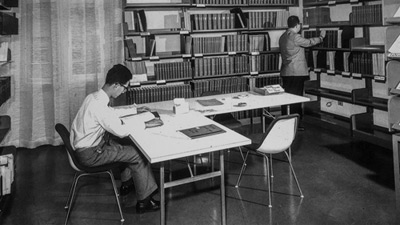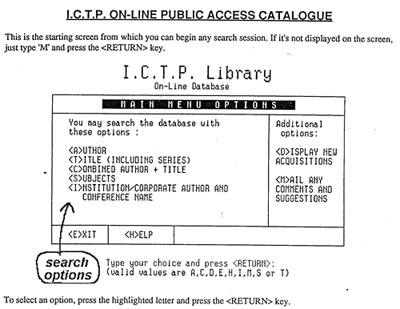- About the Library
- Library Staff
- For Librarians
- A Brief History
- Exhibits
The Centre's inception and its organization mark it as a new type of venture - an assay in collaboration between the East and the West, and the smaller nations; an assay in collaboration for pure science organized under the aegis of the United Nations. The idea is the embodiment of the International ideal; it must succeed.[i]

Over 50 Years in the ICTP Library
ICTP was created in 1964 with ambitious objectives, few dozen visitors and little money, and has grown consistently through the years. The story of the ICTP Library has developed along the same path, marked by its cornerstones.
The seat agreement for the establishment of ICTP read:
"$ 20,000 [allocated] for the acquisition of an initial collection of books/journals through the Institute of Physics, Trieste University."[ii]
After one year, the interim annual report informed that:
"The ICTP is provisionally housed in the centre of the town, not far from the University of Trieste. Sixty physicists are accommodated in the provisional premises. A library (1416 books, and approximately 70 periodicals) is at the disposal of the Scientists. Nearly 120 preprints from theoretical physics institutes are received every month."[iii]
Abdus Salam wanted a library of excellence at ICTP. He wanted it to be always open, free to roam, with no constrictions.
"For the majority of scientists from Eastern Europe and developing countries, the library was extremely important. For many of them it was the first opportunity to see modern textbooks and proceedings of recent scientific meetings from the West and, above all, to browse the scientific journals. Libraries in their home country could not always avail foreign currencies for subscriptions to the main scientific journals in their field."[iv]
Initially confined to high energy, nuclear and plasma physics, the core collection was gradually complemented by condensed matter in the seventies, mathematics in the eighties, earth and environmental sciences and other subjects more recently, to sustain the research groups' activities.
New collections asked for more space, so in the eighties a library annex was opened in the Adriatico Bldg., and a storage area in the Galileo Bldg. Then, in 1990, the main building was doubled, and all the material rejoined in the wider new premises.

Computerization of the catalogue occurred in 1994. The Online Public Access Catalogue or OPAC could be consulted via Telnet, Gopher and the then new and little known World Wide Web, the technology that had been publicly released by CERN only one year before. There was also a homemade automated help system, called e-mail to Library mail server.
The first online subscription dates 1995, and was to Applied Physics Letters. It needed the installation of ad-hoc software, called Guidon. Articles could be printed locally or downloaded as ASCII (text), SGML, or Guidon format files. PDF had not yet become the standard format that is now. The next title to be subscribed online was Physical Review Letters the same year.
The early 2000s saw the digitization of the ICTP preprints and lecture notes archives (2002-2004), a total of about 20,000 documents. Also historical ICTP videos were digitized from VHS. The digital reproduction of the Centre's photographic heritage followed.
The bibliographical database migrated to the Aleph Integrated Library System in 2007. A unified catalogue was created, with a single access to all the materials in any available format.
On 5 December 2008, the ICTP Library was renamed Marie Curie Library.
The Library Today
After over fifty years, the Marie Curie Library online services now include the library website, a memorial website dedicated to Abdus Salam, the unified online catalogue and an article delivery service for scientist in less developed countries called eJDS.
The collections comprise approx. 72,000 print books and over 1,900 current electronic periodicals, about 90 of which are also received in print. Catalogued e-books are over 1,700 and growing. Several thousand digital documents of different types are in the archives.
The English-speaking ICTP Library has finally broken its splendid isolation in Italy, embracing co-operation with great conviction. It is an active member of library associations and consortia for national agreements; it facilitates the access of external visitors, also thanks to ICTP's partnership with the University of Trieste, SISSA and other neighbouring institutions; it has become a major provider of document delivery in Italy, thanks to the quality of its resources and speed of service.
[i] Abdus Salam, The International Centre for Theoretical Physics. Physics Today, v. 18, no. 3, p. 52-53 (March 1965).
[ii] Agreement between the International Atomic Energy and the Government of Italy concerning the establishment of an International Centre for Theoretical Physics at Trieste. Annex II (INFCIRC/51). IAEA (1963).
[iii] The International Centre for Theoretical Physics (interim report). Academic year 1964-1965, p. 14 (1965).
[iv] A.M. Hamende, A guide to the early history of the Abdus Salam International Centre for Theoretical Physics (1960-1968). Trieste, Consortium for the Development of Studies and Research, Departments of Physics, University of Trieste, p. 169 (2002).
















